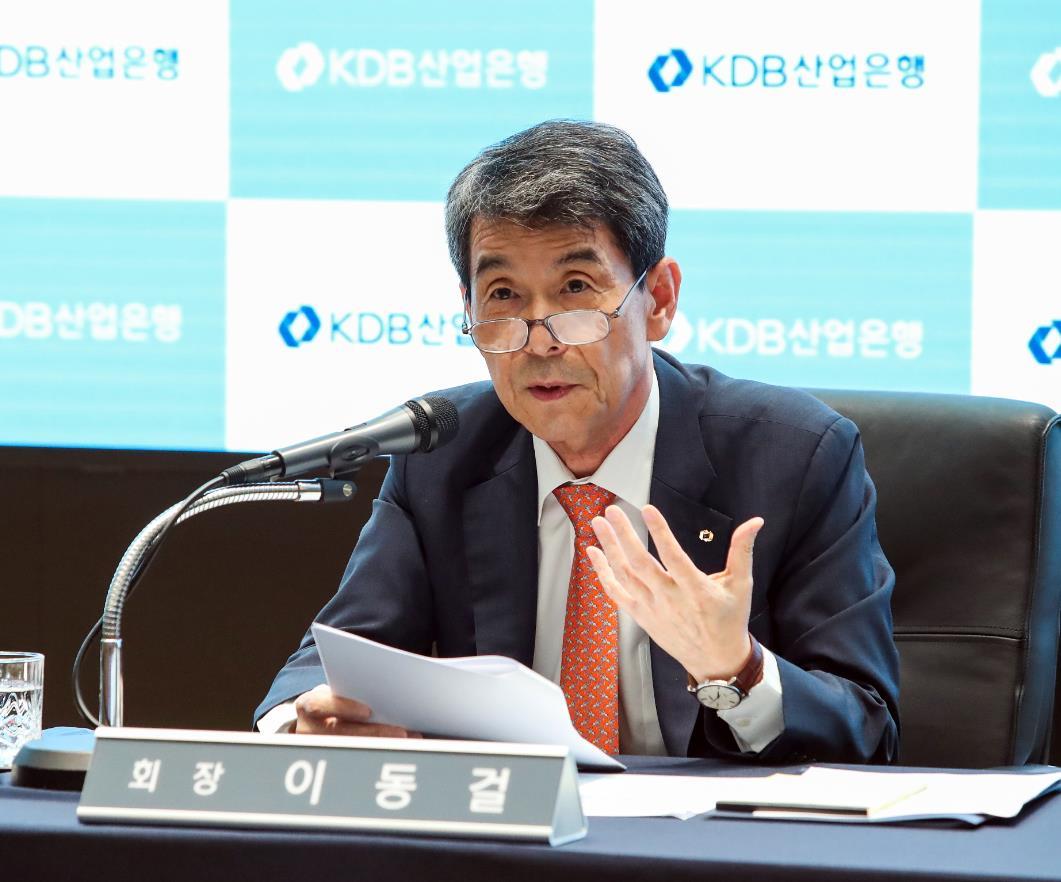KDB chief says SsangYong Motor's ‘cost-saving’ scheme not enough
Main creditor denies reports on pool of potential buyers, says sincere ones absent
By Jung Min-kyungPublished : June 14, 2021 - 18:07

South Korea’s financially ailing carmaker SsangYong Motor’s decision last week to send its employees on rotating unpaid leave for up to two years may not be sufficient enough to catch the eyes of new buyers, the chief of the Korea Development Bank said Monday.
“I would like to thank SsangYong Motor’s leadership and its union on their agreement on the company’s latest self-rescue action focused on sending its employees on rotating unpaid leave –- it’s a big step forward,” KDB Chairman Lee Dong-gull told reporters via an online press briefing. KDB is the main creditor of SsangYong Motor.
“But we need to think carefully about whether it is a sufficient enough plan,” he added, saying that the automaker has yet to take KDB’s “key requests” into account.
SsangYong Motor’s union members recently consented to have half of the workforce -– employees and factory workers -– on rotating unpaid leave in a desperate bid to minimize layoffs under a new buyer, while saving costs.
“SsangYong Motor and its unionists need to think from the investor’s perspective and ways to convince them,” Lee said.
“From the investor’s perspective, they would focus on the timeframe of the plan, whether the issues could be resolved within two years.”
On potential buyers, Lee hinted that the pool remains lackluster. He said “While several are being discussed in the media, it is extremely difficult to find a candidate with sincere intentions.”
The bidding process could wrap up as early as the end of the year, if it goes smoothly, Lee said.
On the possibility of injecting fresh funds into the troubled automaker, Lee said SsangYong Motor needs to draw up and submit a sustainable business plan and display its capability to attract strong buyers to receive financial support.
The state-run lender said in February that it has no plans to funnel additional funds into the automaker unless a viable rehabilitation plan is laid out. At the time, it blamed Mahindra & Mahindra, the Indian parent company of SsangYong that holds a 74.6 percent stake, as a key culprit behind the Korean automaker’s insolvency.
While details of its unpaid leave scheme are yet to be confirmed, the system is slated to begin on July 1.
SsangYong filed for court receivership late last year, as it failed to secure approval for the rollover of 165 billion won ($148 million) worth of loans from creditors.
This marks the second time for SsangYong to face court receivership. It underwent the same process in 2009 and was relieved in 2011 following its acquisition by Mahindra.
In 2009, the automaker laid off 2,600 employees, which accounted for some 36 percent of the entire workforce. The mass layoffs triggered an extensive management-labor dispute, involving special police squad intervention and arrests of key union members.
By Jung Min-kyung (mkjung@heraldcorp.com)
“I would like to thank SsangYong Motor’s leadership and its union on their agreement on the company’s latest self-rescue action focused on sending its employees on rotating unpaid leave –- it’s a big step forward,” KDB Chairman Lee Dong-gull told reporters via an online press briefing. KDB is the main creditor of SsangYong Motor.
“But we need to think carefully about whether it is a sufficient enough plan,” he added, saying that the automaker has yet to take KDB’s “key requests” into account.
SsangYong Motor’s union members recently consented to have half of the workforce -– employees and factory workers -– on rotating unpaid leave in a desperate bid to minimize layoffs under a new buyer, while saving costs.
“SsangYong Motor and its unionists need to think from the investor’s perspective and ways to convince them,” Lee said.
“From the investor’s perspective, they would focus on the timeframe of the plan, whether the issues could be resolved within two years.”
On potential buyers, Lee hinted that the pool remains lackluster. He said “While several are being discussed in the media, it is extremely difficult to find a candidate with sincere intentions.”
The bidding process could wrap up as early as the end of the year, if it goes smoothly, Lee said.
On the possibility of injecting fresh funds into the troubled automaker, Lee said SsangYong Motor needs to draw up and submit a sustainable business plan and display its capability to attract strong buyers to receive financial support.
The state-run lender said in February that it has no plans to funnel additional funds into the automaker unless a viable rehabilitation plan is laid out. At the time, it blamed Mahindra & Mahindra, the Indian parent company of SsangYong that holds a 74.6 percent stake, as a key culprit behind the Korean automaker’s insolvency.
While details of its unpaid leave scheme are yet to be confirmed, the system is slated to begin on July 1.
SsangYong filed for court receivership late last year, as it failed to secure approval for the rollover of 165 billion won ($148 million) worth of loans from creditors.
This marks the second time for SsangYong to face court receivership. It underwent the same process in 2009 and was relieved in 2011 following its acquisition by Mahindra.
In 2009, the automaker laid off 2,600 employees, which accounted for some 36 percent of the entire workforce. The mass layoffs triggered an extensive management-labor dispute, involving special police squad intervention and arrests of key union members.
By Jung Min-kyung (mkjung@heraldcorp.com)


![[AtoZ into Korean mind] Humor in Korea: Navigating the line between what's funny and not](http://res.heraldm.com/phpwas/restmb_idxmake.php?idx=644&simg=/content/image/2024/04/22/20240422050642_0.jpg&u=)


![[Herald Interview] Why Toss invited hackers to penetrate its system](http://res.heraldm.com/phpwas/restmb_idxmake.php?idx=644&simg=/content/image/2024/04/22/20240422050569_0.jpg&u=20240422150649)
![[Exclusive] Korean military set to ban iPhones over 'security' concerns](http://res.heraldm.com/phpwas/restmb_idxmake.php?idx=644&simg=/content/image/2024/04/23/20240423050599_0.jpg&u=20240423183955)
![[Graphic News] 77% of young Koreans still financially dependent](http://res.heraldm.com/phpwas/restmb_idxmake.php?idx=644&simg=/content/image/2024/04/22/20240422050762_0.gif&u=)







![[Exclusive] Korean military to ban iPhones over security issues](http://res.heraldm.com/phpwas/restmb_idxmake.php?idx=652&simg=/content/image/2024/04/23/20240423050599_0.jpg&u=20240423183955)



![[Today’s K-pop] Ateez confirms US tour details](http://res.heraldm.com/phpwas/restmb_idxmake.php?idx=642&simg=/content/image/2024/04/23/20240423050700_0.jpg&u=)